This page is based on this
Wikipedia article Text is available under the
CC BY-SA 4.0 license; additional terms may apply.
Images, videos and audio are available under their respective licenses.

Cloves are the aromatic flower buds of a tree in the family Myrtaceae, Syzygium aromaticum. They are native to the Maluku Islands in Indonesia, and are commonly used as a spice. Cloves are available throughout the year due to different harvest seasons in different countries.
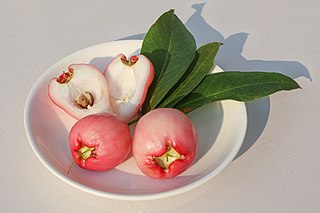
Syzygium samarangense is a plant species in the family Myrtaceae, native to an area that includes the Greater Sunda Islands, Malay Peninsula and the Andaman and Nicobar Islands, but introduced in prehistoric times to a wider area and now widely cultivated in the tropics. In Indonesia it is known as Jambu Air and it is known as macopa in Tagalog but Visayan people in the Southern part of the Philippines called it Tambis.

Syzygium is a genus of flowering plants that belongs to the myrtle family, Myrtaceae. The genus comprises about 1200–1800 species, and has a native range that extends from Africa and Madagascar through southern Asia east through the Pacific. Its highest levels of diversity occur from Malaysia to northeastern Australia, where many species are very poorly known and many more have not been described taxonomically.

Syzygium cumini, commonly known as jambolan, Java plum, black plum or jamun, is an evergreen tropical tree in the flowering plant family Myrtaceae. It is native to the Indian Subcontinent, adjoining regions of Southeast Asia, China and Queensland. The name of the fruit is sometimes mistranslated as blackberry, which is a different fruit in an unrelated order. Syzygium cumini has been spread overseas from India by Indian emigrants and at present is common in former tropical British colonies.
The cherry is the fruit of many plants of the genus Prunus. The plants themselves are also called cherries, and the wood they produce is called cherry.

The magenta lilly pilly, also known by the common name magenta cherry, is a broad dense bushy rainforest tree native to New South Wales. It grows to a height of 15 m with trunk diameter up to 35 cm. Leaves are 3–9 cm long, opposite, simple and slightly obovate, tapering at the leaf base. The leaves are dark glossy above, and paler below. White flowers are produced in clusters. The edible fruit is usually magenta, but can be white, pink or purple.

Syzygium jambos is a tree originating in Southeast Asia and occurring widely elsewhere, having been introduced as an ornamental and fruit tree.

Syzygium malaccense is a species of flowering tree native to Malesia and Australia. It is one of the species cultivated since prehistoric times by the Austronesian peoples. They were carried and introduced deliberately to Remote Oceania as canoe plants. In modern times, it has been introduced throughout the tropics, including many Caribbean countries and territories.
Syzygium microphyllum is a species of plant in the Myrtaceae family. It is endemic to India. It is threatened by habitat loss. In 1998 the now disputed taxon Syzygium gambleanum was listed as extinct in the IUCN Red List. However, after research work by the Royal Botanic Gardens Kew this plant was revealed as identical with Syzygium microphyllum and so the name Syzygium gambleanum became an illegitimate synonym.
Syzygium cordifolium is a species of plant in the Myrtaceae family. It is endemic to Sri Lanka.
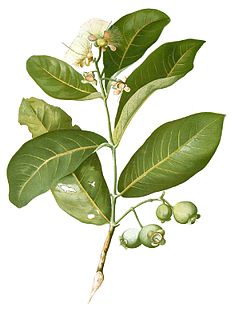
Syzygium aqueum is a species of brush cherry tree. Its common names include watery rose apple; names like "water apple" and "bell fruit" may refer to any species of Syzygium grown for its fruit.
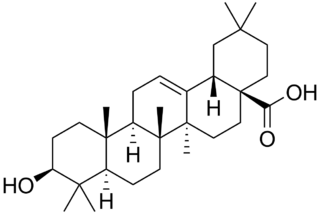
Oleanolic acid or oleanic acid is a naturally occurring pentacyclic triterpenoid related to betulinic acid. It is widely distributed in food and plants where it exists as a free acid or as an aglycone of triterpenoid saponins.
Syzygium guineense is a leafy forest tree of the Myrtaceae family, found in many parts of Africa both wild and domesticated. Both its fruits and leaves are edible; the pulp and the fruit skin are sucked and the seed discarded. It is sometimes called "waterberry", but this may also refer to other species of Syzygium.
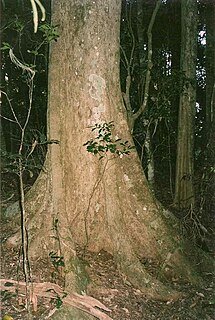
Syzygium crebrinerve is a fairly common Australian tree, growing from near Taree, New South Wales to Calliope in Queensland. Common names include purple cherry, rose satinash, and black water gum. The habitat of Syzygium crebrinerve is sub tropical rainforest on basaltic or fertile alluvial soils.
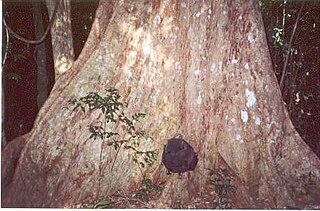
Syzygium francisii is a native Australian tree, common on the eastern sea board, between Morisset, New South Wales and Gladstone, Queensland. Common names include giant water gum, rose satinash, and Francis water gum. The habitat of Syzygium francisii is rainforest on basaltic or fertile alluvial soils.
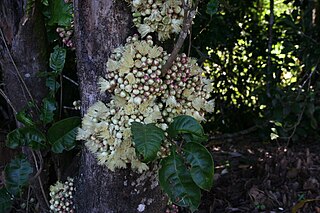
Syzygium cormiflorum, commonly known as the bumpy satinash, is a species of Syzygium tree native to Queensland in northeastern Australia.













